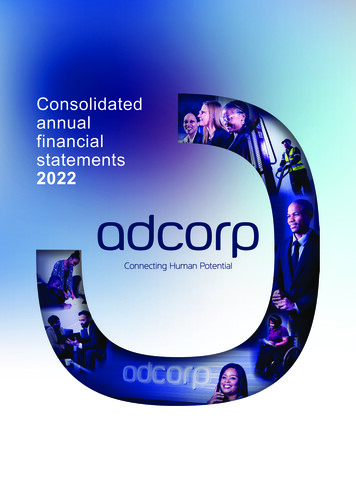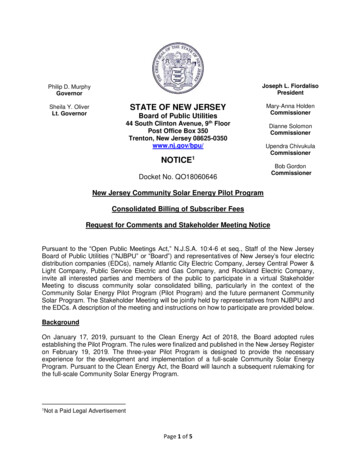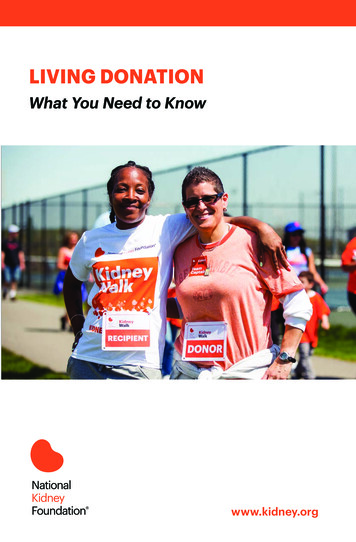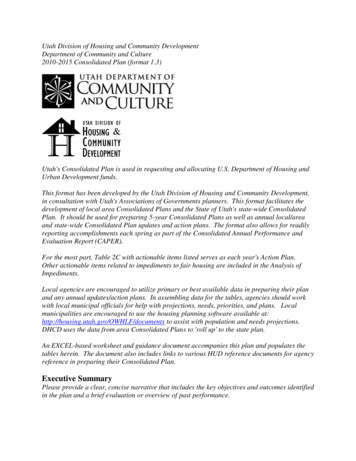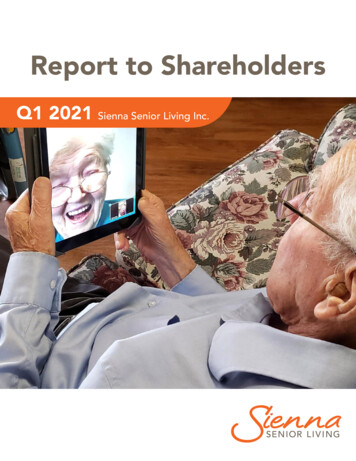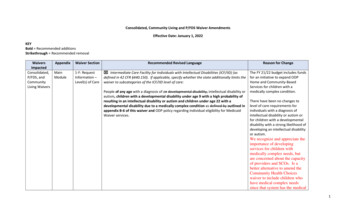
Transcription
Consolidated, Community Living and P/FDS Waiver AmendmentsEffective Date: January 1, 2022KEYBold Recommended additionsStrikethrough Recommended removalWaiversImpactedConsolidated,P/FDS, andCommunityLiving WaiversAppendixWaiver SectionMainModule1-F: RequestInformation –Level(s) of CareRecommended Revised Language Intermediate Care Facility for Individuals with Intellectual Disabilities (ICF/IID) (asdefined in 42 CFR §440.150). If applicable, specify whether the state additionally limits thewaiver to subcategories of the ICF/IID level of care:People of any age with a diagnosis of an developmental disability, intellectual disability orautism, children with a developmental disability under age 9 with a high probability ofresulting in an intellectual disability or autism and children under age 22 with adevelopmental disability due to a medically complex condition as defined by outlined inappendix B-6 of this waiver and ODP policy regarding individual eligibility for MedicaidWaiver services.Reason for ChangeThe FY 21/22 budget includes fundsfor an initiative to expand ODPHome and Community-BasedServices for children with amedically complex condition.There have been no changes tolevel of care requirements forindividuals with a diagnosis ofintellectual disability or autism orfor children with a developmentaldisability with a strong likelihood ofdeveloping an intellectual disabilityor autism.We recognize and appreciate theimportance of developingservices for children withmedically complex needs, butare concerned about the capacityof providers and SCOs. Is abetter alternative to amend theCommunity Health Choiceswaiver to include children whohave medical complex needssince that system has the medical1
WaiversImpactedAppendixWaiver SectionRecommended Revised LanguageReason for Changecapacity and experience?Minimally, there needs to be adetailed outline of thedocumentation that would berequired in regards to MedicallyComplex Conditions whenEPSDT and Community HealthChoices could be an option interms of waiver as a funding oflast resort.Consolidated,P/FDS andCommunityLiving WaiversMainModule2: Brief WaiverDescription:The Consolidated, P/FDS, Community Living Waiver has been developed to emphasizedeinstitutionalization, prevent or minimize institutionalization and provide an array ofservices and supports in community-integrated settings. The Consolidated, P/FDS,Community Living Waiver is designed to support persons of any age with andevelopmental disability intellectual disability or autism, children with a developmentaldisability under age 9 with a high probability of resulting in an intellectual disability orautism and children under age 22 with a developmental disability due to a medicallycomplex condition to live more independently in their homes and communities and toprovide a variety of services that promote community living, including participantdirected service models and traditional agency-based service models.The FY21/22 budget includes fundsfor an initiative to expand ODPHome and Community-BasedServices for children with amedically complex condition.Will the new waiver “slots” begiven to children who are currentlyon the wait list who meet thiscriteria, or will a new list bedeveloped? What will be done tohelp with building capacity in thecommunity? Will the number ofslots designated for this increase infuture years? We have a concernregarding risk management for thispopulation given the currentresources available to SCOs, andproviders in regard to medicalexpertise and professional support.The rates for this service would2
WaiversImpactedAppendixWaiver SectionRecommended Revised LanguageReason for Changeneed to be adequate to allow forthe additional supports necessary.Consolidated,CommunityLiving, andP/FDSWaiversB-1-aTarget Groupsx Intellectual Disability or Developmental Disability, or Bothx Autism – Minimum Age: 0, Maximum Age Limit: nonex Developmental Disability – Minimum Age: 0, Maximum Age Limit: 8 21x Intellectual Disability – Minimum Age: 0, Maximum Age Limit: noneConsolidatedCommunityLiving, andP/FDSWaiversB-1-cTransition ofIndividualsAffected byMaximum AgeLimitation.Participants who are enrolled with a developmental disability with a high probability ofresulting in an intellectual disability or autism will be reevaluated using theICF/ID criteria for an intellectual disability or ICF/ORC criteria for a diagnosis ofautism during their 8th year (prior to their 9th birthday). If they are eligible, they willcontinue to receive waiver services. If the participant is not eligible, he or she will bereferred to other resources. Individuals will be referred to the Office of Children, Youthand Families as applicable and the Office of Mental Health and Substance Abuse Services.Individuals who have a developmental disability due to a medically complex conditionhave the option to enroll in the waiver only if they are age 0 to 21. Once a participantreaches age 22, the participant will be given the option to remain enrolled in the waiverafter age 22 or transition to another program.ConsolidatedWaiverB-3-aUnduplicatedNumber ofParticipantsYear 5 – 18981 19,081The FY21/22 budget includes fundsfor an initiative to expand ODPHome and Community-BasedServices for children with amedically complex condition.If the age limit listed here fordevelopmental disability is age 21,what will happen to theseindividual at age 22?The FY21/22 budget includes fundsfor an initiative to expand ODPHome and Community-BasedServices for children with amedically complex condition.Much needs to be done toprepare the community servicesto handle this populationincluding providers receivingtraining, supports, etc. If 20children are not able to beplaced with in the year, will thefunds continue to be availablethe following year (not lost)The FY 21/22 budget includesfunding for 100 additionalindividuals to be served in theConsolidated Waiver, including 20children with a medically complexcondition. Why is the Consolidatedwaiver only impacted here, yet3
WaiversImpactedConsolidatedandCommunityLiving WaiversAppendixB-3-cWaiver SectionReservedWaiverCapacityRecommended Revised LanguagePurpose (provide a title or short description to use for lookup):Children with a Medically Complex ConditionPurpose (describe):Administrative Entities (AEs) work in conjunction with ODP and its designees to anticipateand prioritize the needs of children with a medically complex condition who are expectedto require waiver services within the year due to transition or diversion from an extendedhospital stay or from a facility licensed under 55 Pa. Code Chapter 3800, 6400 or 6600that does not meet waiver HCBS requirements.Reason for Changeabove changes also include P/FDSand Community Living?The FY 21/22 budget includes fundsfor an initiative to expand ODPHome and Community-BasedServices for children with amedically complex condition.The capacity that the State reserves in each waiver year is specified in the following table:Year 1 – 0Year 2 – 0Year 3 – 0Year 4 – 20 Consolidated and 20 Community LivingYear 5 – 20 Consolidated and 20 Community LivingConsolidated,CommunityLiving andP/FDSWaiversB-3-cReservedWaiverCapacityPurpose: Hospital/Rehabilitation CareODP reserves waiver capacity for participants requiring: Hospital care beyond 30 consecutive days and up to 6 consecutive months fromthe first date of leave when they are not receiving any waiver services duringthat time; or Rehabilitation care beyond 30 consecutive days and up to 6 consecutive monthsfrom the first date of leave.Waiver capacity will be reserved for participants requiring hospital or rehabilitationcare in the following settings: which are considered hospital/rehabilitation care includemedical and psychiatric hospital settings, rehabilitation care programs and nursinghomes. Waiver capacity will not be reserved for participants requiring hospital orThis change aligns the waivers withthe Social Security Act, which wasamended by the CARES Act, toallow services to be delivered in ahospital.We support reserving capacity andalso request clarification – whenindividuals enter rehab care, willindividuals enter reserved capacity,or must they enter CHC?4
WaiversImpactedConsolidated,CommunityLiving andP/FDSWaiversAppendixB-6-dWaiver SectionLevel of CareCriteriaRecommended Revised Languagerehabilitation care in the following settings: which are not consideredhospital/rehabilitation care include residential treatment facilities, state mental healthhospitals, approved private schools and private and state ICFs/ID.Also we request that theserequirements be aligned with theTSM regulations.3. Developmental Disability with a high probability of intellectual disability or autismprior to age 9 ICF/ORC***The FY21/22 budget includes fundsfor an initiative to expand ODPHome and Community-BasedServices for children with amedically complex condition.4. Developmental Disability due to a medically complex condition prior to age 22ICF/ORCi. There are four fundamental criteria that must be met prior to an individualbeing determined eligible for an ICF/ORC level of care:Consolidated,CommunityLiving andP/FDSWaiversB-6-fProcess forLevel of CareEvaluation/ReevaluationReason for Change1. Have a medically complex condition defined as one or more chronic healthconditions that meet both of the following: (a) cumulatively affect three ormore organ systems; and (b) require medically necessary nursingintervention to execute medical regimens to use technology for respiration,nutrition, medication administration or other bodily functions;2. Individual is 21 years of age or younger;3. Have substantial adaptive skills deficits in three or more areas of major lifeactivity: self-care, understanding and use of language, learning, mobility,self-direction and/or capacity for independent living based on astandardized adaptive functioning test; and4. Be recommended for an ICF/ORC level of care based on a medicalevaluation.The following four criteria must be met to document a diagnosis of a medically complexcondition and determine eligibility upon initial certification:1. A licensed physician, including a developmental pediatrician, licensed physician’sassistant or certified registered nurse practitioner must certify on DP 1090 that theindividual has a medically complex condition.There have been no changes tolevel of care requirements forindividuals with a diagnosis ofintellectual disability or autism orfor children with a developmentaldisability with a strong likelihood ofdeveloping an intellectual disabilityor autism.The FY21/22 budget includes fundsfor an initiative to expand ODPHome and Community-BasedServices for children with amedically complex condition.5
WaiversImpactedAppendixWaiver SectionRecommended Revised Language2. A QDDP certifies that the individual has impairments in adaptive behavior based onthe results of a standardized assessment of adaptive functioning which shows that theindividual has both of the following:a. Significant limitation in meeting the standards of maturation, learning, personalindependence, or social responsibility of his or her age and cultural group; andb. Substantial adaptive skill deficits in three or more areas of major life activity: selfcare, understanding and use of language, learning, mobility, self-direction and/orcapacity for independent living based on a standardized adaptive functioning test.Reason for ChangeThere have been no changes tolevel of care requirements forindividuals with a diagnosis ofintellectual disability or autism orfor children with a developmentaldisability with a strong likelihood ofdeveloping an intellectual disabilityor autism.3. The individual is 21 years of age or younger.4. The results of a medical evaluation completed within the previous 365 days thatreflects the individual’s current medical condition. The medical evaluation may be themedical evaluation approved by the Department (Form MA 51), or an examination thatis completed by a licensed physician, licensed physician’s assistant, or certifiedregistered nurse practitioner that states the individual is recommended for an ICF/ORClevel of care.ConsolidatedCommunityLiving, maker services enable the participant or the family member(s) or friend(s) withwhom the participant resides to maintain their primary private home. This service canonly be provided when a household member is temporarily absent or unable to managethe home, or when no landlord or provider agency staff is responsible to perform thehomemaker activities. Homemaker services include cleaning and laundry, mealpreparation, and other general household care. Homemaker services also includeinfection control measures and intensive cleaning for participants whose medicallycomplex condition requires this level of service. Infection control and intensive cleaningcan include cleaning medical equipment, disinfecting the home, etc.The Homemaker/Chore servicedefinition was revised to meet thespecific needs of participants with amedically complex condition.Please note, other changes weremade to restructure the contentfor clarity.RCPA Supports this proposedchange to expand this definitionCHORE6
WaiversImpactedAppendixWaiver SectionRecommended Revised LanguageReason for ChangeChore services consist of services needed to maintain the home in a clean, sanitary, andsafe condition. Chore services consist of heavy household activities such as washingfloors, windows, and walls; tacking down loose rugs and tiles; moving heavy items offurniture in order to provide safe access and egress; ice, snow, and/or leaf removal; andyard maintenance. In the case of rental property, the responsibility of the landlord,pursuant to the lease agreement, will be examined prior to any authorization of service.Maintenance in the form of upkeep and improvements to the participant’s home isexcluded from federal financial participation.Homemaker/Chore services can only be provided in the following situations when thereis no other relative, caregiver, landlord, community/volunteer agency, provider agencystaff, or third-party payer that is capable of or responsible for the provision: Neither the participant, nor anyone else in the household, is capable of performingthe function; and No other relative, caregiver, landlord, community/volunteer agency, or third partypayer is capable of or responsible for the provision.1. When a participant and household members are temporarily unable to performHomemaker/Chore functions covered under the service definition. Examplesinclude: If a participant has a temporary medical need due to a hospitalization orfrom a surgery, and as a result, the caregiver does not have time to performthe Homemaker/Chore functions due to the increased care needs of theparticipant. If the caregiver who usually performs the Homemaker/Chore functions hasa temporary medical condition that renders them unable perform theHomemaker/Chore functions. There is no one else that is capable of orresponsible for the provision of the Homemaker/Chore functions. The household member who usually performs the Homemaker/Chorefunctions is temporarily absent and there is no one else that is capable of orresponsible for the provision of the Homemaker/Chore functions.2. When a participant or household member is permanently unable to perform theHomemaker/Chore functions. Examples include:7
WaiversImpactedAppendixWaiver SectionRecommended Revised Language Reason for ChangeThe participant has a medical need or disability that requires constantdirect care which results in the caregiver not having time on a routine basisto perform Homemaker/Chore functions.The caregiver has more than 1 child and Homemaker/Chore services wouldenable the caregiver to spend more time providing care to the childparticipant who has a medical need or disability.The service plan team is responsible for determining whether a person is temporarily orpermanently unable to perform the Homemaker/Chore functions. The service planteam’s determination must be documented in the service plan.Participants authorized to receive Homemaker/Chore services may not be authorized toreceive the following services as Homemaker/Chore tasks are built into the rates for theseservices: Residential Habilitation Services, Life Sharing or Supported Living.This service must be delivered in Pennsylvania.ConsolidatedCommunityLiving, Home accessibility adaptations are an outcome based vendor service that consists ofcertain modifications to the private home of the participant (including homes owned orleased by parents/relatives/friends with whom the participant resides and Life Sharinghomes that are privately owned, rented, or leased by the host family or participant). Themodification(s) must be necessary due to the participant’s disability or medical needs, toensure the health, security of, and accessibility for the participant, or which enable theparticipant to function with greater independence in the home. This service may only beused to adapt the participant's primary residence. For participants with a medicallycomplex condition who need home accessibility adaptations to transition from aninstitutional setting, the adaptations can occur no more than 180 days prior to theparticipant moving into their primary residence. A provider or OHCDS may not bill forhome accessibility adaptations until the participant moves out of the institutionalsetting and into the participant’s primary residence. may not be furnished to adapthomes that are owned, rented, leased, or operated by providers except when there is aneeded adaptation for participants residing in a Life Sharing setting and the life sharingThe Home Accessibility Adaptationservice definition was revised tomeet the specific needs ofparticipants with a medicallycomplex condition and to reflectthe coverage of home accessibilitydurable medical equipmentthrough the Medical Assistancestate plan.Please note, other changes weremade to restructure the contentfor clarity.We believe that finding contractorsto provide these services that will8
WaiversImpactedAppendixWaiver SectionRecommended Revised Languagehost home is owned, rented or leased by the host and not the Life Sharing provideragency.Home accessibility adaptations must have utility primarily for the participant, be an itemof modification that the family would not be expected to provide to a family memberwithout a disability, be an item that is not part of general maintenance of the home, andbe an item or modification that is not part of room and board costs as defined in 55 Pa.Code Chapter 6200. Home modifications consist of installation, repair, maintenance, andextended warranties for the modifications; and when necessary to comply withrental/lease agreements, return of the property to its original condition.All modifications shall meet the applicable standards of manufacture, design, andinstallation and Modifications shall be specific to the participant’s needs and not beapproved to benefit the public at large, staff, significant others, or family members;modifications or improvements to the home that are of general utility are excluded. Alladaptations to the household shall be provided in accordance with applicable buildingcodes.Modifications not of direct medical or remedial benefit to the participant are excluded.Reason for Changeagree to wait for payment until theindividual moves to the new sitewill be very difficult. Also will airconditioning cover the entire site,or only the room the individualuses? If the expenditures willexceed the limit, is there a varianceprocess? What modifications toexisting deck are allowable (iemodifications need to be definedby an OT or PT?) How will biddingprocess be coordinated with stateplan vendor? In situations whereparents share joint custody, is thelimit per person still in place?The following are covered as modifications to a household subject to funding under theWaivers: Ramps from street, sidewalk or house; Vertical lifts; Portable or track lift systems. A portable lift system is a standing structure that can bewheeled around. A track lift system involves the installation of a “track” in the ceilingfor moving an individual with a disability from one location to another; Handrails and grab-bars in and around the home; Accessible alerting systems for smoke/fire/CO2 for individuals with sensoryimpairments.9
WaiversImpactedAppendixWaiver SectionRecommended Revised Language Reason for ChangeElectronic systems that enable someone with limited mobility to control variousappliances, lights, telephone, doors, and security systems in their room, home orother surroundings.Outside railing from street to home;Widened doorways, landings, and hallways.An additional doorway needed to ensure the safe egress of the participant duringemergencies, when a variance is approved by the ODP Regional Office (a variance isnot required for participants with a medically complex condition).Swing clear and expandable offset door hinges.Flush entries and leveled thresholds.Replacement of glass window panes with a shatterproof or break resistant materialfor participants with behavioral issues as noted in the participant’s service plan;Slip resistant flooring.Kitchen counter, major appliance, sink and other cabinet modifications.Modifications to existing bathrooms for bathing, showering, toileting and personalcare needs.Bedroom modifications of bed, wardrobe, desks, shelving, and dressers.Stair gliders and stair lifts. A stair lift is a chair or platform that travels on a rail,installed to follow the slope and direction of a staircase, which allows a user to rideup and down stairs safely;Workroom modifications to desks and other working areas.Modifications needed to accommodate a participant’s special sensitivity to sound,light, or other environmental conditions.In addition to the modifications listed above, the following home accessibilityadaptations are also included for participants with a medically complex condition: Air conditioning if the participant has a medical need for specific temperatureregulation. Electrical rewiring if the participant needs life-support equipment.10
WaiversImpactedAppendixWaiver SectionRecommended Revised Language Reason for ChangeInstallation of specialized electric and plumbing systems that are necessary toaccommodate the participant’s medical equipment and supplies.Installation of flooring supports needed to support the weight of the participant’smedical equipment.For home accessibility durable medical equipment used by participants with a mobilityimpairment to enter and exit their home or to support activities of daily living coveredby medical assistance in the state plan (such as ramps, lifts, stair glides, handrails, andgrab bars), Home Accessibility Adaptations shall only include the following: Extended warranties for the home accessibility durable medical equipment. Repairs of the home, including repairs needed as a result of the installation, useor removal of the home accessibility durable medical equipment or appliance. Any of the following required to install home accessibility durable medicalequipment:o Adding internal supports such that the support requires access to the areabehind a wall or ceiling or underneath the floor to install homeaccessibility durable medical equipment.o Constructing retaining walls or footers for a retaining wall if needed toinstall home accessibility durable medical equipment.o Modifications to an existing deck.o Widening a doorway.o Upgrades to the home’s electrical system.o Demolition of drywall or flooring.Home Accessibility Adaptations do not include modifications that: Are not specifically identified in the service definition. Are not of direct medical or remedial benefit to the participant. Are not needed as a result of the participant’s medical needs or disability. The family or caregiver would be expected to make for an individual without adisability. Are for general maintenance of the home. Are part of room and board.11
WaiversImpactedAppendixWaiver SectionRecommended Revised Language Reason for ChangeHave a primary benefit for a caregiver, staff person, family member, or thepublic at large.Are used in the construction of a new home or any new room in the home.Are durable medical equipment.Adaptations that add to the Adding total square footage to the home is excluded fromthis service, unless an adaptation to an existing bathroom is needed to complete thehome accessibility adaptation (e.g., necessary to configure a bathroom to accommodatea wheelchair). Building a new room is excluded. Home accessibility adaptations may notbe used in the construction of a new home.Durable medical equipment is excluded. To the extent that any listed services arecovered under the state plan, including EPSDT, the services under the waiver would belimited to additional services not otherwise covered under the state plan, but consistentwith waiver objectives of avoiding institutionalization.At least three bids must be obtained for Home Accessibility Adaptations that cost morethan 1,000. The least expensive bid must be chosen, unless there is documentation fromthe service plan team that justifies not choosing the lowest bid. If three contractors,companies, etc. cannot be located to complete the Home Accessibility Adaptations,documentation of the contractors or companies contacted must be kept in theparticipant's file.Participants authorized to receive Residential Habilitation services may not be authorizedto receive Home Accessibility Adaptations. This service must be delivered in Pennsylvania.Maximum state and federal funding participation is limited to 20,000 per participantduring a 10-year period. The 10-year period begins with the first utilization of authorizedHome Accessibility Adaptations. A new 20,000 limit can be applied when the participantmoves to a new home or when the 10-year period expires. In situations of joint custody(as determined by an official court order) or other situations where a participant divides12
WaiversImpactedAppendixWaiver SectionRecommended Revised LanguageReason for Changetheir time between official residences, the adaptations must be allowable services andmust be completed within the overall monetary limit of 20,000 for this service.***A variance may be requested for the 20,000 limit and approved by ODP for any of thefollowing situations: Maintenance or repair to existing home accessibility adaptations when it is notcovered by a warranty or home owners insurance and the maintenance or repair ismore cost effective than replacing the home accessibility adaptation; or Track lift systems that exceed the limit and will reduce the need for other services; If the participant has a medically complex condition and there is a change to theparticipant’s medical condition or status that require additional home iving WaiversC-1/C-3Life SharingFor the purposes of Life Sharing the following definitions apply:**** Host family - One or more persons with whom the participant lives in a private home,such as the participant’s relative(s), legal guardian, or persons who are not related tothe participant. The host family is responsible for, and actively involved in, providing careand support to the participant in accordance with the service plan.With the expansion of waiverservices to participants with amedically complex condition, theservice definition was revised tomeet the specific need of theseindividuals.***Services consist of assistance, support and guidance (physical assistance, instruction,prompting, modeling, and positive reinforcement) in the general areas of self-care, healthmaintenance, decision making, home management, managing personal resources,communication, mobility and transportation, relationship development and socialization,personal adjustment, participating in community functions and activities and use ofcommunity resources.Please note, other changes weremade to restructure the contentfor clarity.Life Sharing services may be provided up to 24 hours a day based on the needs of theparticipant receiving services. The type and amount of assistance, support and guidanceare informed by the assessed need for physical, psychological, medical, and or emotionalassistance established through an the assessment or screening (including the Health Risk13
WaiversImpactedAppendixWaiver SectionRecommended Revised LanguageReason for ChangeScreening Tool) and person-centered planning processes. The type and amount ofassistance are delivered to enhance the autonomy of the participant, in line with theirpersonal preference and to achieve their desired outcomes.Life Sharing services are often the primary residence of the participant and as such, it ishis or her home. This includes ensuring assistance, support and guidance (prompting,instruction, modeling, positive reinforcement) will be provided as needed to enable theparticipant to:***3. Manage or participate in the management of his or her medical care includingscheduling and attending medical appointments, filling prescriptions and selfadministration of medications, ensuring that there is a sufficient amount of medicalsupplies so the participant will not be at risk of not having the supplies, and keepinghealth logs and records.***Life Sharing services may only be used to meet the exceptional needs of the participantwho is under age 18 that are due to his or her disability or medical needs and are aboveand beyond the typical, basic care for a child that all families with children mayexperience.ConsolidatedandCommunityLiving WaiversC-1/C-3Life SharingSupplemental Habilitation may be used as a Life Sharing staffing add-on in emergencysituations or to meet a participant’s temporary medical or behavioral needs.Supplemental Hab
Jan 1, 2022

